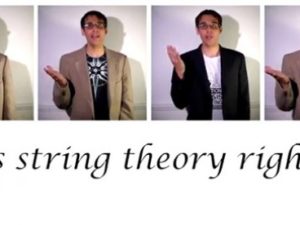The Neuroscience of the Bar Mitzvah
Attending a recent Bar Mitzvah ceremony, I was impressed, once again, by the wisdom of this ancient tribal initiation ceremony. The 13-year-old boy (or girl, in what’s called a Bat Mitzvah) is surrounded by family and friends as he recites the Torah portion in Hebrew and offers a short sermon about the importance of the reading. The ceremony takes place in the context of a regular communal service with the entire congregation assembled.
Seventy percent of the primal cultures studied by anthropologists have some formal adolescent-initiation practice. Some are for males only, some for females only, and some for both. These rites of passage can involve separation, seclusion, physical hardship, psychological stress, deprivation of food or sleep, and sometimes also torture and bodily mutilation. These initiation rites precede marriage, reproduction, and adult responsibilities. In the case of contemporary American Judaism, the initiation ordeal involves going to Hebrew school for a couple of years—a form of torture for many of these kids who would rather be playing computer games or hanging out with their friends on the weekend.
The initiation of adolescents intuits something profound about our brains. Neuroscientists now understand that brains grow and evolve throughout life, but especially in childhood. Most of the brain’s structure is laid out by the time a child is 5 or 6. Then, just before puberty, the prefrontal cortex begins to grow again. Located in the forehead, the prefrontal cortex is the brain’s CEO and is involved in making plans, controlling behavior, organizing memory, modulating emotions, delaying gratification, and making complex decisions.
Brain maturation involves growing and then pruning back dendrite and synaptic formations. Some neuronal connections are enhanced through the formation of lipid sheaths around the axons that speed and strengthen neural transmissions. This process is known as myelination, the conversion of gray-matter neurons into white-matter neurons.
This pruning and myelination process, as we now understand it, continues into our 20s, and myelinated neuronal connections play an important role in learned mental processes. It is now believed that once our brain matures and its nerve fibers become myelinated, we become less receptive to learning new concepts. Humans have universal dispositions to learn language, music, and religion; but the specific language, genre of music, and religious tradition are matters of the geography and culture of birth—and if you’ve tried to learn a language or instrument late in life, you know how hard it is. So if you want to reinforce a communal identity, it helps to get at those myelinating young neurons before the adolescent hormones and emotions start raging.
At the Bar Mitzvah I was privileged to attend, I couldn’t help but think that the tribe had done this young man a great service, literally surrounding him with family and friends expressing loving affirmation and setting high expectations for his future. For this boy, not really yet a man, success, however measured, is the only option. The investment in time and money on the Bar Mitzvah will likely offer a better and earlier return than what will later be spent on his college education.
Adolescents have ways of initiating themselves in the absence of a formal coming-of-age ritual. This peer-group self-initiation can resemble the Lord of the Flies—senseless vandalism, petty crimes, and juvenile delinquency acted out by young boys in groups. Young girls tend to get in different kinds of trouble. It may be that those cultures that do not have a formal adolescent initiation ceremony do so at great risk to their wellbeing and survival. What we don’t invest in initiation, we later pay for in incarceration.
It may take a family to raise a child, but it takes a tribe to raise a teenager. And in our global civilization, the tribe that increasingly matters most is the entire human family. That lesson was also imparted at the boy’s Bar Mitzvah, which emphasized not only his Jewish identity and responsibilities as he becomes a man, but also the importance of service to humanity. And thus the performance of this symbolic rite becomes a blessing to us all.
I’d love to hear from readers: How did you experience adolescent initiation (or not) and how do you think about this for your own children?
Follow-up Response
Thanks for the many comments. It seems my blog on the Neurosciences of Bar/Bat Mitzvahs “hit a nerve” with many Huff Post readers.
As I make clear in my book, The New Sciences of Religion, whether a religious practice or belief is functional or dysfunctional is context specific, differentially so for individuals and groups. In some contexts, it makes sense to raise kids to be great hunters or ferocious warriors. It depends on the surrounding competitive- cooperative environment.
Judaism initiates their children by having them learn a foreign language (Biblical Hebrew), read and interpret an ancient text (the Torah), and speak in public (the Bar/Bat Mitzvah ceremony). It is the process that matters, not a perfunctory ritual. The lavish parties that sometimes follow contemporary Bar/Bat Mitzvahs, I would argue, actually diminish the learning process and transmit negative and dysfunctional messages to their kids.
In the 21st century, children raised in subcultures that elevate learning and public speaking as a source of admiration and achievement get an added boost in life. I think it is healthier to focus teenage urges for recognition, achievement, and competition on more elevated pursuits, but certainly other values and pursuits can substitute for this and with different outcomes in a range of possible selective environments.
Families exist in cultures and subcultures. Together they set expectations that we consciously and unconsciously live into and mold ourselves. These are also evolved neurological expectations in the development of our brains!
Whether a religious belief is true — in the way that science and history are true — is a completely different set of questions, which I will address in future blog posts.
Originally published on the Huffington Post Religion Section, 2011/12/10.



